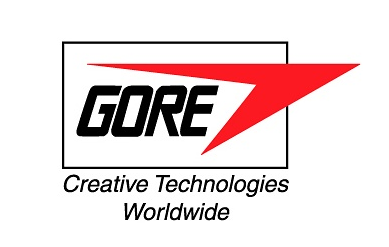Part 3:
Harry Potter
and the
Curse of the PowerPoint Slides
This has **NOTHING** to do with Harry Potter (just this Muggle's dread and horror of PowerPoint slides), and is PART THREE of an intermittent series on the case:
Bard Peripheral Vascular, Inc. et al. v. W.L. Gore & Associates, Inc.
* * * * * * * * * * * * * * * * * * * * * * * * * * * * * * * * * * * * * * * * * * * * * *
Fun With Google
I google everything. There, I just googled you. You look ... great in that bathing suit. No, really.
You can also find the strangest things.
While looking around to understand this case better, I found what appears to be some version of the slides Gore used to argue inequitable conduct to the judge, located here: www.parkborchert.com/samples/Demonstrative002.ppsx
WHA-HUH?!?!?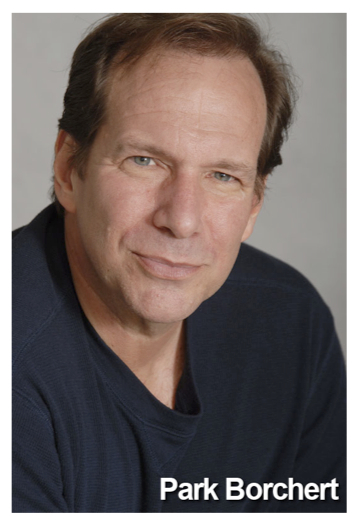 The eponymous Park Borchert seems to be an actor who also freelances as a graphic artist in patent litigations. Mebbe. These slides may have nothing to do with the case (yeah, they're probably some kid's science project), but they do correlate very closely with the fact patterns behind one or more of Gore's inequitable conduct arguments. However, even if they were made for the case, there is no indication that these slides were actually presented in court at any point.
The eponymous Park Borchert seems to be an actor who also freelances as a graphic artist in patent litigations. Mebbe. These slides may have nothing to do with the case (yeah, they're probably some kid's science project), but they do correlate very closely with the fact patterns behind one or more of Gore's inequitable conduct arguments. However, even if they were made for the case, there is no indication that these slides were actually presented in court at any point.
But these slides are a great example of how patent attorneys torture judges&juries everywhere. It is the same in almost every patent case: the PowerPoint (ppt) slide with a document on one side, and a blow-up of some of the text on the other side, ... and some highlighting, ... oh, and, hey, let's add more language and an extremely complex headline (full of irrelevant details). Even better, let's show twenty or thirty of these slides in a row!! And then let's just smash some bottles of ether on the courtroom floor for anyone still conscious after this vicious assault of aggressive boredom!
Yep, there are slides like these are in almost every case. But that doesn't make it right. The visuals shown to the judge&jury should be supportive of one or more central themes in your story, but the details on these slides just take over and overwhelm.
Slides, SLIDES, SLIDES!!
I am going to force you to look at all 21 slides, so that you understand the pain, anguish, boredom and confusion of any jury that is forced to look at slide after slide after slide after slide. I have also made up the reactions of a jury listening, although this was likely argued to the Judge alone.
SLIDE 1
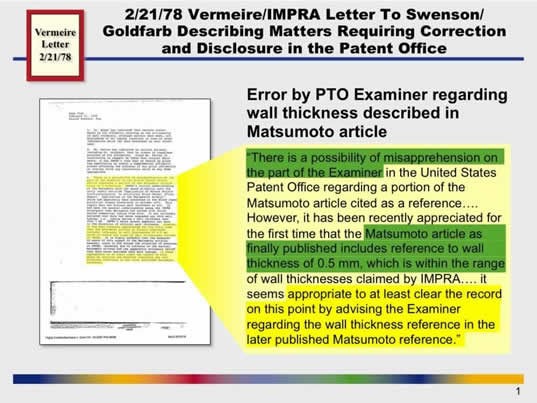
Juror #2: Wow, you're asking me to absorb a lot of information here. Is all of this really necessary? What's important? What's the point?
[tidgenote: this slide is the industry standard visual for pulling out text from a document. First, it has way too much information that is not that important. Second, it has too little guidance as to what information is important, what's the overall point, what the presentation will encompass, etc. Patent attorneys may see the point of the slide automatically, but without clear guidance judge&jury will easily become confused.
FYI: Goldfarb is the named inventor who, with Bard, sued Gore for patent infringement. Swenson was Goldfarb's attorney back in the 1970's when Goldfarb fell out with his ex-company IMPRA, which filed his patent application and was the assignee. So Vermiere, on IMPRA's behalf, wrote this nastygram to Goldfarb, claiming the history of the patent application they were fighting over was full of errors and inconsistencies which needed to be fixed.
It's interesting to note that, long before Gore made its inequitable conduct argument to the court, the Judge had ruled that the wall thickness didn't matter.
In a complex fact pattern, one must think very carefully before voluntarily taking on the burden of explaining it all to the judge&jury--particularly in this case, where witnesses and parties change sides and change stories over a tortuous 30-year history with multiple lawsuits.]
SLIDE 2
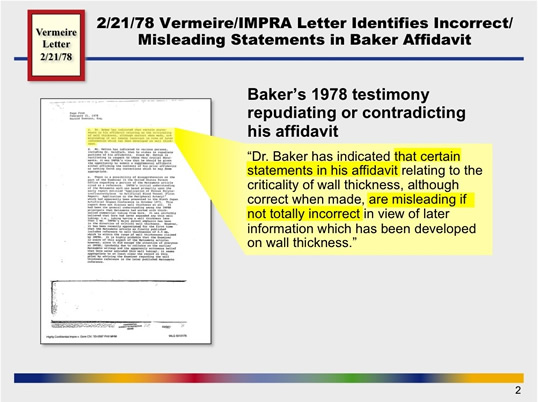
Juror #2: OK, more of the same. This letter seems pretty important.
SLIDE 3
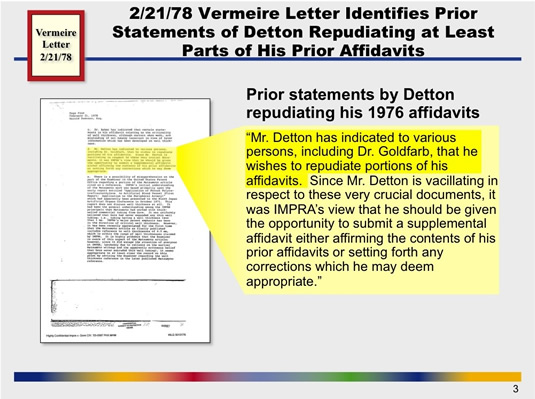
Juror #2: I wonder why this letter was written--it seems more like an attack than a list of possible problems.
SLIDE 4
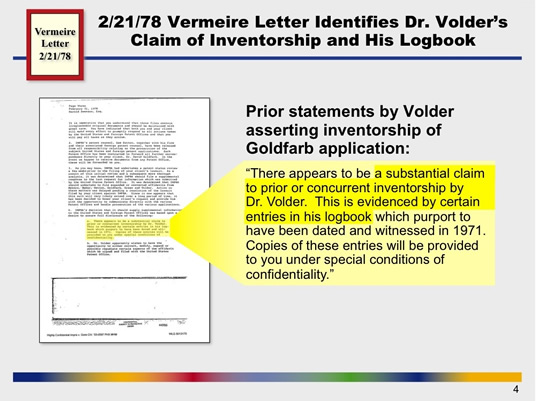
Juror #5: This guy Vermeire clearly had a bone to pick with this patent application. Why do we care?
SLIDE 5
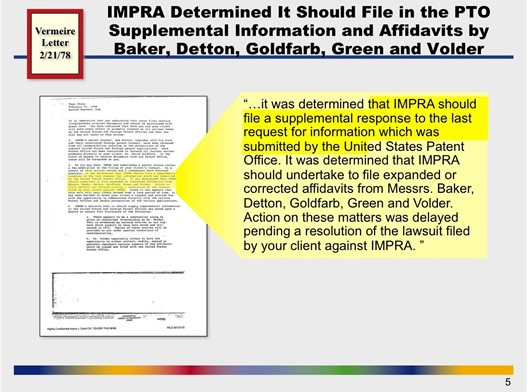
Juror #10: Wait .. wha-? Why would IMPRA be filing anything with the Patent Office? Oh, IMPRA was prosecuting Goldfarb's patent application for awhile .... wait, what? Why? IMPRA and Goldfarb started out working together and then sued each other--what happened there? Does it matter? Are they in this suit?
SLIDE 6
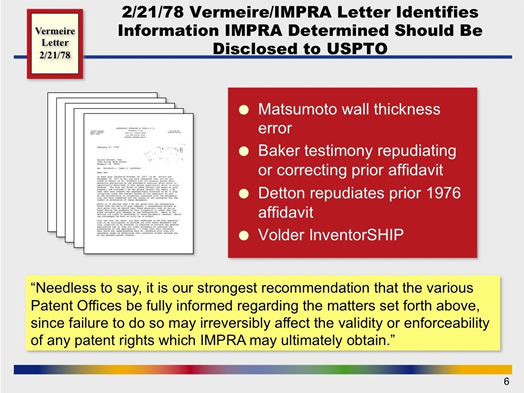
Juror #10: Um .. OK. So even if this stuff wasn't true, Goldfarb had a duty to take some action in regards to the allegations, ... right? Well, was any of it true? If it was, would it matter? And, if it wasn't, why report any of it? I mean, these guys were enemies, right? Why believe any of it?
SLIDE 7
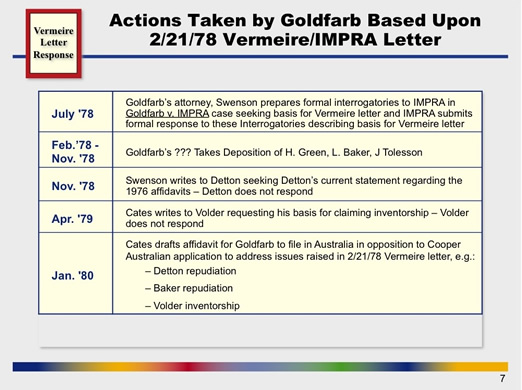
Juror #10: I thought you were going to tell me that Goldfarb ignored the letter, or burned it, or did nothing--instead you show me a list of actions Goldfarb took? Sounds like Goldfarb took the letter and his duty very seriously. Besides the fact that Goldfarb took a lot of actions in response to the letter, I am going to remember nothing from this slide. ... And I am getting sleepy, how much more is there?
[tidgenote: The "???" might indicate these are draft slides.]
SLIDE 8
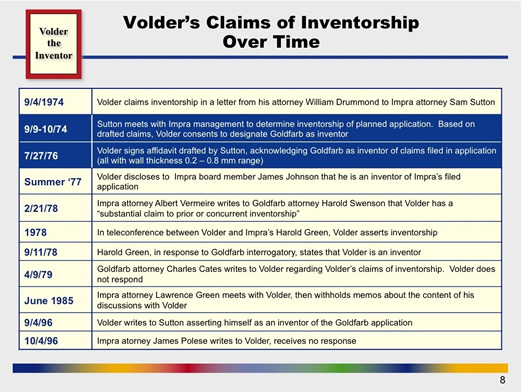
Juror #6: When did we switch to lists of events? Why did we? Who's this guy Volder again? ... ... ... OK, he's another guy who flip-flopped, saying he wasn't an inventor and then saying he was? Yeah, we can just forget any of the crap on this slide. Christ, most of it is between people suing each other: why believe any of it?
[tidgenote: Cool, Volder(mort) has arrived!! If the argument is non-disclosure, .... um, how is that the point of this slide?]
SLIDE 9
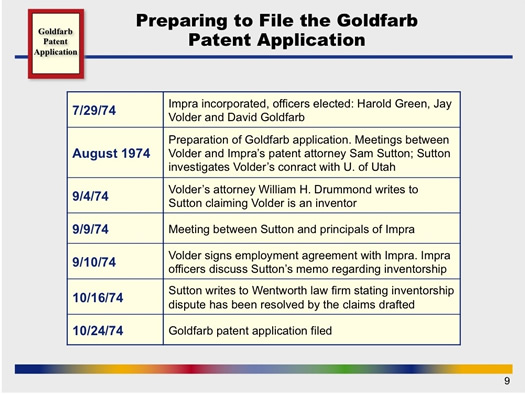
Juror #1: .... huh, .... I think I'll take the family out to dinner tonight ... Somewhere nice ... That Italian place, mebbe? ... hmmm ... Oh damn, the Judge just looked over: look awake! Look attentive! What's this slide about? Filing the application? Yeah, OK, whatever.
SLIDE 10
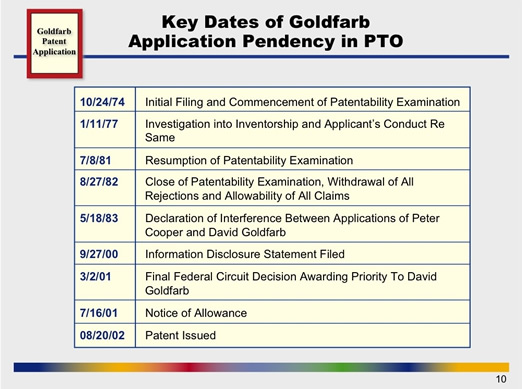
Juror #8: Stay awake ... stay awake ... stay awake. How much more of this is there? Is anything on this slide important? Why? For whom?
SLIDE 11
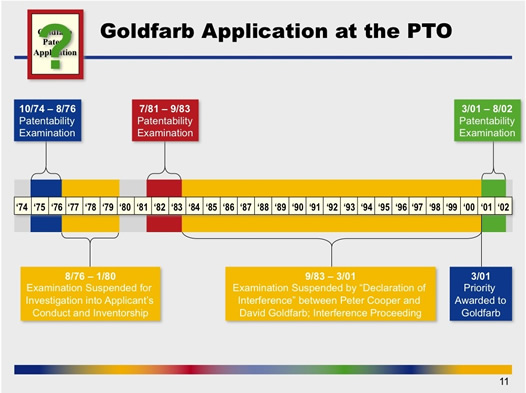
Juror #5: Hey, the animated version just shows the timeline at first and then adds each of the events in chronological order. ... ... ... um, why do I care? Is this important? Not important? Just the framework? At slide 11?!?
SLIDE 12
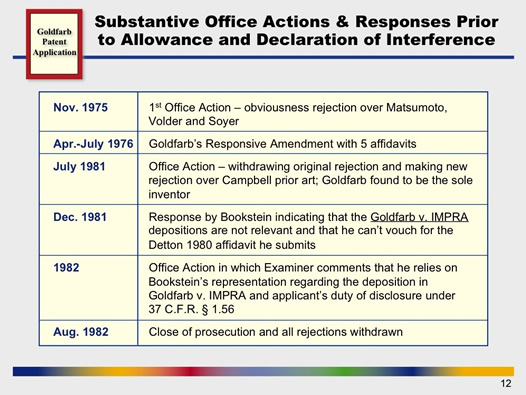
Juror #2: I wonder if Bill's gay? Why doesn't that prospect frighten me? How did we grow so apart? When did we stop caring?
SLIDE 13
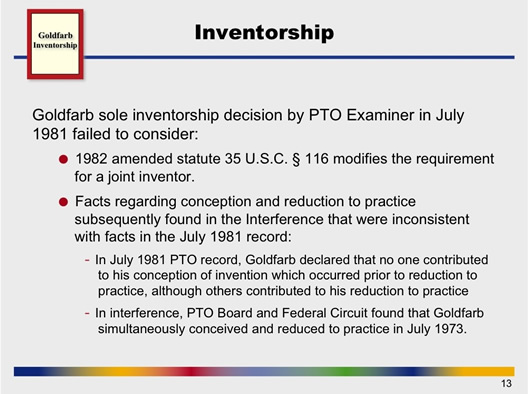
Juror #6: All in all, the lunches have been pretty good here. Wow, that lawyer is really trying to make some point. ... wait, did she say something that mattered? ... statute changed ... does it matter? ... what is all this legalese? ... I'll ask somebody later. Oh no, we can't talk about the case. ... Whatever.
SLIDE 14
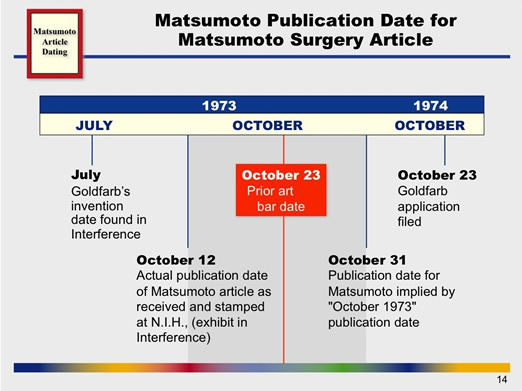
Juror #3: Oh yeah, baby, I remember 1973. Was that really almost 40 years ago!?!? Man.
SLIDE 15
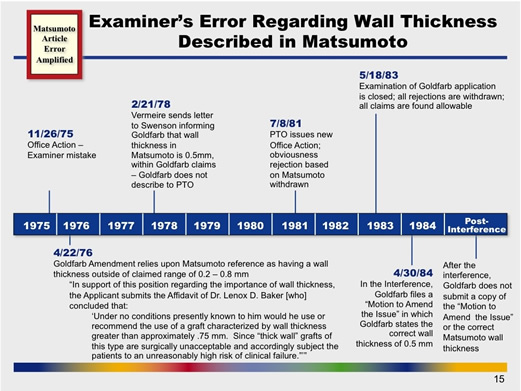
Juror #5: ... ... ... redrum ... ... ... redrum ... .... ...
SLIDE 16
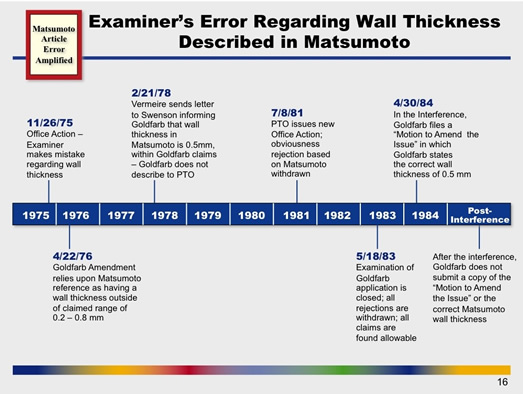
Juror #2: Is this a new slide? I don't remember. The Examiner made an error? Whose fault is that, anyway? Does that count against one of the parties in this suit? ... Huh. ... This looks like a new courtroom; it's nice. Why are there no windows? A little sunlight would be nice.
SLIDE 17
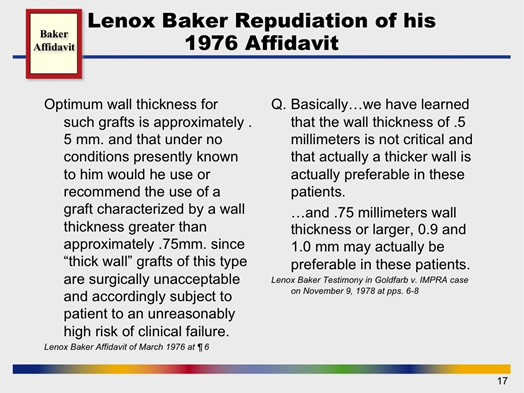
Juror #11: ....snore .... snore ... snore ...
SLIDE 18
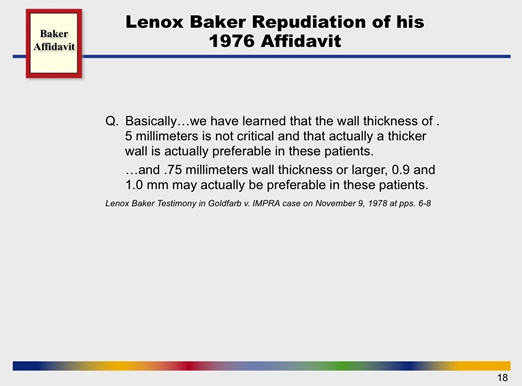
Juror #7: The court reporter is kinda hot. Was she looking at me? I think she was looking at me during that break. Can I talk to her? Will I get arrested or something? ... wait, will she know I'm married? Damn.
SLIDE 19
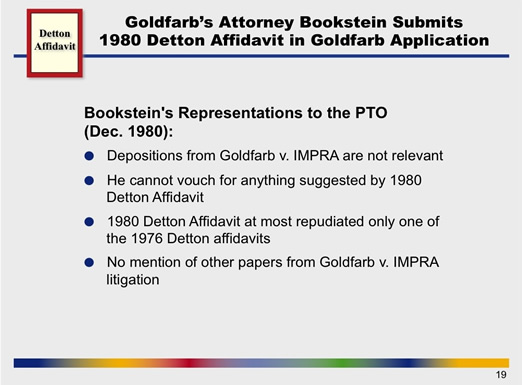
Juror #10: I don't know if my life is worth living anymore.
SLIDE 20
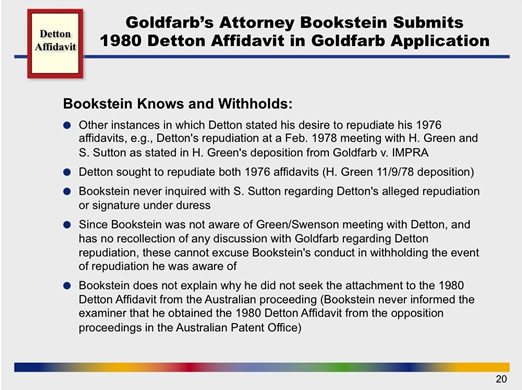
Juror #9: OH MY GOD!! STOP!! STOP!! FOR THE LOVE OF GOD, PLEASE STOP THIS!!
SLIDE 21
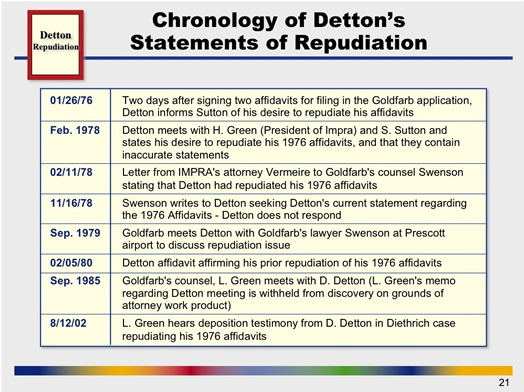
Juror #4: Jeez, lawyers: "Chronology of Detton's Statements of Repudiation"--la ti da. Look at me, I'm a lawyer. La ti da. How much does that guy make? I bet he gets flights on corporate jets and shit. All for boring the hell out of us. Still, it's better than being an investment banker. Christ, I'd like to kill one of those sonuvabitches.
* * * * * * * * * * * * * * * * * * * * * * * * * * * * * * * * * * * * * * * * * * * * * *
I am not making fun of jurors here, I AM MAKING FUN OF THE LAWYERS WHO PUT THEM THROUGH THIS CRAP. The jurors are doing their best to meet their civic duty, and the lawyers are torturing them as a captive audience.
It's too much: there is no central point, no image, no idea, tying it all together except clearly the slidemaker thinks Goldfarb did something wrong.
Whether or not these particular slides had anything to do with this particular case, I'm sure the Gore attorneys fell into the usual quagmire of complex details that patent litigators seem to delight in, despite the mind-numbing effects of such detail-mongering on judge&jury.
This can be avoided. Many patent litigators don't actually put together any visuals until right before presentation. So in that harried time-crunch, they put everything in. Presumably, if given enough time, they would slice and dice these things down to the essentials.
A lawyer should be thinking, from the very start of the case, of good visuals to show why s/he is right and/or the other side is wrong. Examples and details should be used to highlight the story, to prove its truth. Instead, with slides like these, the details become the story--what are judge&jury supposed to hold onto here?
Slides are also often an example of when the graphics crew takes over the job of the lead attorney--telling the story to the jury. The lawyer must control what is focussed upon, PEOPLE TELL STORIES, the technology just helps the storyteller do his or her job. Only the storyteller can know how to weave in the various elements at the right time, and in the right way.
Inequitable conduct is tough for visuals. The best is a witness who clearly appears untrustworthy (whether by video or live at trial), but that's fairly rare -- no matter what patent litigators think, judge&jury do not interpret the hesitation, lack of memory, fear, and/or confusion of a deponent being grilled by a lawyer as "evidence" of lying. Everybody inevitably uses timelines as visuals for inequitable conduct, but they are not really necessary: the crucial facts are someone knew and didn't disclose.
In this case, it would be a difficult task to isolate and present key points without getting mired in the complex history of the parties involved with the patent, but if you can't, you should consider how strong your argument is and whether you'd be better off dropping it. In this case, not only are there too many details, but you get killed by all of the "but's"-- (1) perhaps things about the wall thickness were not disclosed (slides 1, 2, 6, 15-18), but the Patent Office and the Judge found that wall thickness didn't matter; (2) clearly Detton lied at some point, as his statements are inconsistent (slides 3, 5-7, 19-21), but he seems untrustworthy, if not unstable, and it's wise to ignore everything he said/says; (3) Volder claimed inventorship, but he also seemed to repudiate it (slides 4-9), and all of this happened in the context of multiple lawsuits decades ago, so, once again, it's wiser to simply not credit any of it; etc.
Too many parties, too many flip-flops, too many old lawsuits. Something may stink here, but how do you use it? How do you tell what you want, without being overwhelmed by explaining all of the other details of the entire history? It seems the only effective use here might be for cross-examination and impeachment: all of the flip-flops and inconsistencies can be used to cast doubt on everything Goldfarb says, and to cast doubt on the Patent Office's award of the patent to Goldfarb. And just contradict specific factual points; let the other side try to explain the context of it all.
* * * * * * * * * * * * * * * * * * * * * * * * * * * * * * * * * * * * * * * * * * * * * *
But I'm just getting started, there's more commentary on this case coming (proposed topics below, but we'll see what happens):
- Wherefore Art Thou "Porosity?"
- Dude, You're Seriously Bringing up 101? [tidgenote: see ref in Mayo article]
- Under AIA, Gore Would Have Won--Automatically?!? or, How Leahy-Smith's Brave New World Sucks
* * * * * * * * * * * * * * * * * * * * * * * * * * * * * * * * * * * * * * * * * * * * * *
